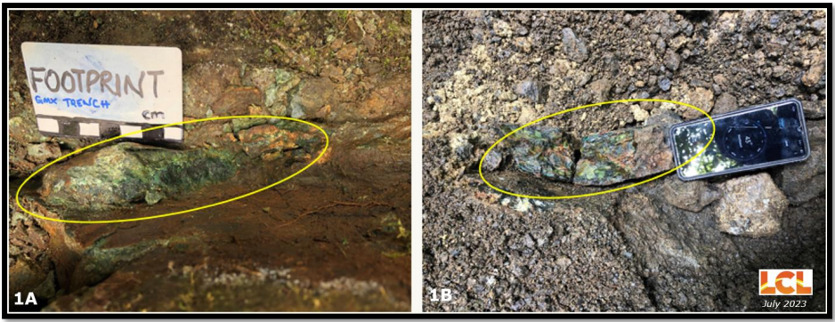Resources Top 4: Nickel rich boulders ‘up to 1m diameter’ hint at significant find in PNG

Picture: Getty Images
- Two rigs are spinning at Adavale’s Kabanga Jirani nickel project in Tanzania, where final assays are pending for a handful of holes
- LCL uncovers a 200m wide corridor of high-grade nickel sulphides; include nickel-rich boulders up to 1m diameter
- Dateline hits 81.35m at 2.57g/t gold from 81.01m
Here are the biggest small cap resources winners in early trade, Thursday July 20.
ADAVALE RESOURCES (ASX:ADD)
Two rigs are spinning at ADD’s flagship Kabanga Jirani nickel project in Tanzania, where final assays are pending for a handful of holes.
“With each rig drilling a hole every 7-10 days, we expect regular newsflow over the coming months,” the company said mid-July.
ADD’s project is adjacent to the Tier-1, high grade Kabanga deposit, one of the largest undeveloped nickel sulphide projects in the world.
Kabanga contains 58Mt of resources at an average nickel grade of 2.62%, up to an even higher equivalent of 3.14% when copper and cobalt credits are included.
Major miners Glencore and Barrick previously spent hundreds of millions on exploration and predevelopment at Kabanga, which was put in mothballs when nickel prices took a dive.
It is now part owned by BHP (ASX:BHP). Development of a 30-year, 65,000tpa ni eq operation is underway, with first production anticipated in 2025.
$15m capped ADD is up 35% year-to-date. It recently raised $1.65m via placement at 1.9c/sh (plus attaching option at 3c/sh).
LCL RESOURCES (ASX:LCL)
The proven mine hunter previously known as Los Cerros has uncovered a 200m wide corridor of high-grade nickel sulphides – include nickel-rich boulders up to 1m in diameter — at the Veri Veri project in PNG.
Multiple surface samples return over 10% nickel sulphides – that’s high grade — including a trench of 3m @ 2.11%Ni and 0.23g/t Au.
Veri Veri is a distinctive hydrothermal nickel sulphide-gold system. It could also be very big, LCL says.

“The company is encouraged by the very high grade and frequency of nickel sulphide boudins [boulders] noted along and across the strike of the corridor, and its potential to yield bulk nickel grades of economic significance,” LCL says.
“LCL geologists were impressed with ‘boulder fields’ of nickel sulphides and, when random pits/trenches were excavated within the corridor, nickel sulphide-bearing outcrops up to 13.38% Ni and 5.35g/t Au were found that confirmed surface boulders (boudins) to be in situ and not transported float.”
Next steps include airborne electromagnetic (EM) geophysical surveys “appropriate for the steep topography and poor exposure”.
LCL, which is also hitting serious paydirt at the Kusi gold target in PNG, recently diversified into the mineral-rich country as it waits for “greater clarity on new government mine development policies” in Colombia.
LCL’s 2.6Moz Quinchia project in Colombia is currently the focus of low-cost project development studies.
The $35m capped explorer is down 25% year-to-date. It had $8.6m in the bank at the end of March.
COOPER METALS (ASX:CPM)
CPM has identified 11 new copper-gold targets on its Ardmore tenement from rock chips sampling which returned grades up to 17.1% copper and 0.79g/t gold.
All up, it has over 50 targets to work with across its 1600sqkm Mt Isa East project in QLD, which we think is probably enough for now.
Cooper’s team is currently in the field systematically checking these targets, managing director Ian Warland says.
“Cooper believes that the results of the recent RC drilling at Ardmore South indicates the presence of a significant IOCG mineral system in the area, with the potential to form economic concentrations of Cu-Au mineralisation in structurally controlled trap sites,” he says.
“The company is planning to drill test as many targets as possible in the 2023 field season and will provide updates as plans develop.”
The 13-hole, 1745m drill program at Ardmore South didn’t hit paydirt, but did “confirm broad areas of copper anomalism in most drill holes”.
“Encouragingly, the IP survey at Ardmore South was successful in identifying a broad sulphide rich zone dominated by pyrite and low-grade copper indicating the presence of a potentially large fertile IOCG mineralising system at Ardmore,” it says.
The $7m capped minnow is down 30% year-to-date. It had $2.6m in the bank at the end of March.
DATELINE RESOURCES (ASX:DTR)
DTR has punched one straight down the guts at its 813,000oz Colosseum gold mine in California, hitting 81.35m at 2.57g/t gold from 81.01m.
The ongoing 8-hole program is targeting high-grade areas within the two mineralised near-vertical ‘pipes’ at Colosseum where there is low drill density.
This, and a previous hit of 76.2m @ 8.62g/t Au, is a big improvement on the existing resource grade of 1.2g/t.
The results of this program will be used to update the resource.
“We now have results from two holes and are drilling the third hole, CM23-09 which has reached a length that is beyond the original design and is still in the breccia pipe,” DTR managing director Stephen Baghdadi says.
“This indicates that the actual breccia pipe is wider than was previously known.
“Our last three holes have had intersections of 100, 75 and 81 metres of a gold-bearing zone comprising several rock types within the breccia pipe.
“All three holes intersect gold grades that are greater than the current average mineral resource grade.”
Meanwhile, DTR says rare earths drilling at Colosseum will kick off this quarter.
The $30m capped stock is down 35% year to date. It recently offloaded its share in the troubled Gold Links gold mine and Lucky Strike mill for up to $12m in cash payments.
UNLOCK INSIGHTS
Discover the untold stories of emerging ASX stocks.
Daily news and expert analysis, it's free to subscribe.
By proceeding, you confirm you understand that we handle personal information in accordance with our Privacy Policy.








